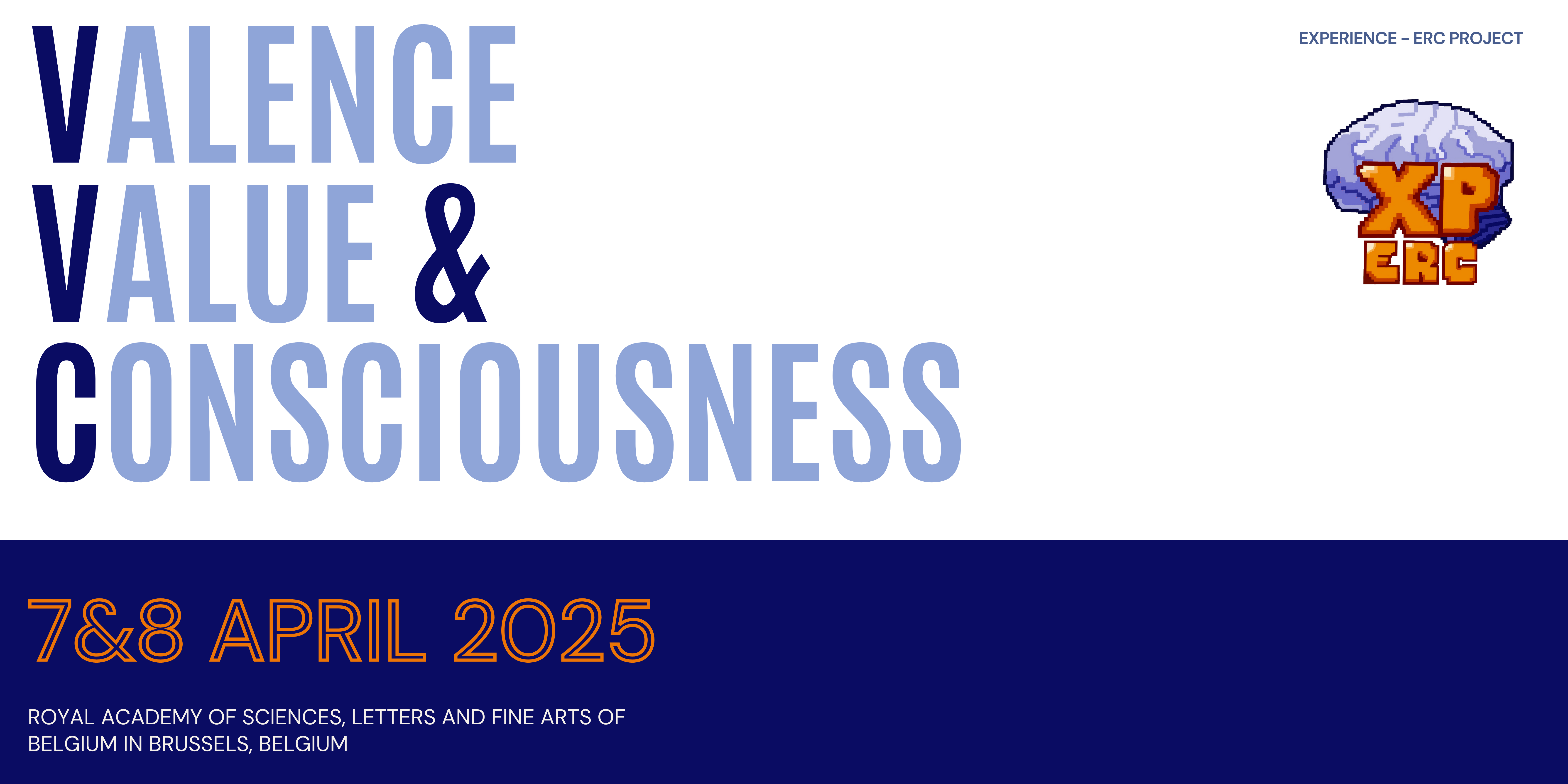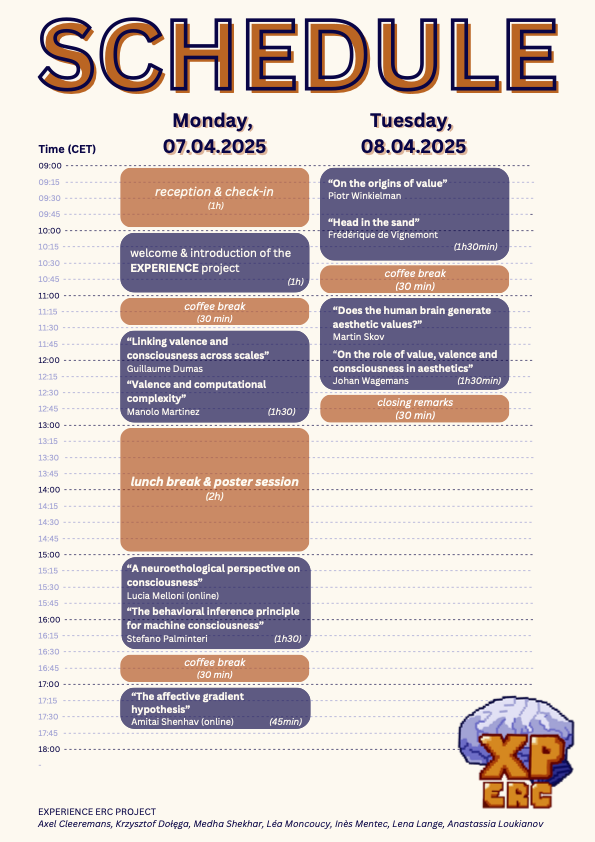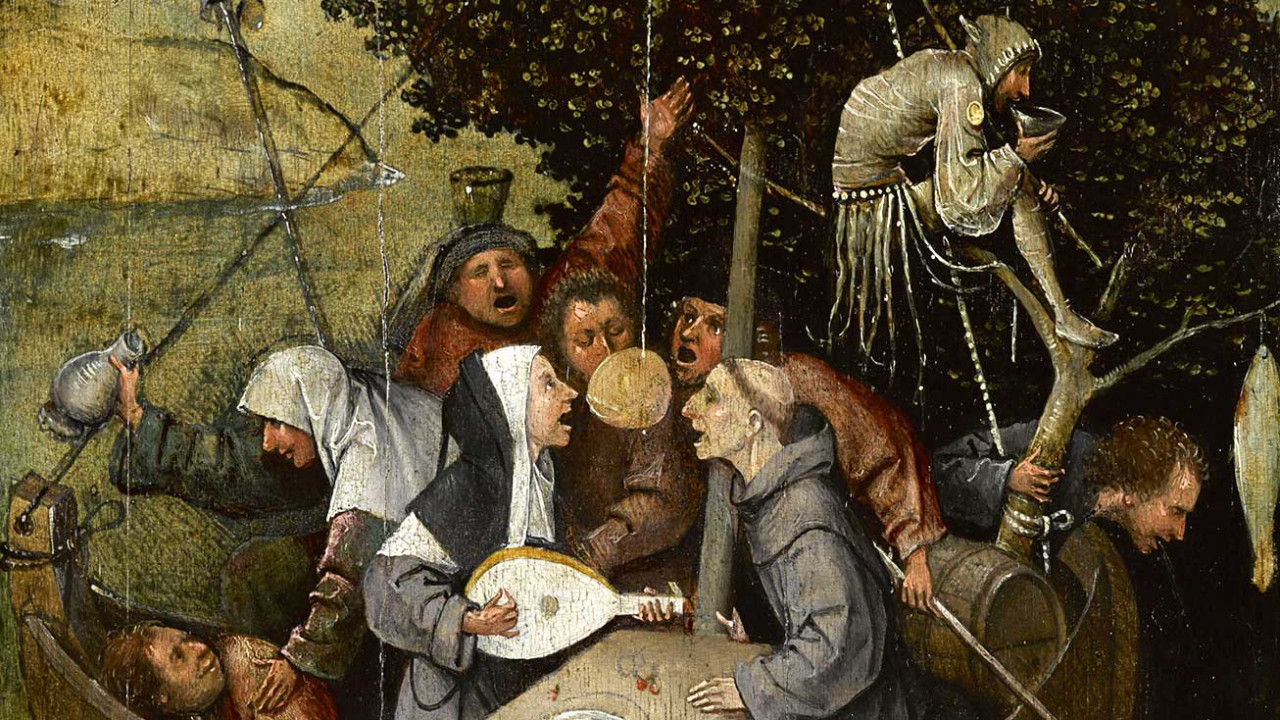
The EXPERIENCE ERC team is excited to announce its second workshop, “Value, Valence, and Consciousness”, taking place on April 7–8, 2025, in Brussels, Belgium.
This interdisciplinary event will explore topics central to the EXPERIENCE project, with a focus on the role of valence in consciousness and the value of phenomenal experience. Discussions will draw insights from various fields of cognitive sciences, including psychology, neuroscience, and philosophy.
Details
- Venue: Royal Academy of Sciences, Letters and Fine Arts of Belgium, Brussels
- Dates: April 7–8, 2025
- Registration: The event is free, but registration is now closed
Featured Speakers
We are thrilled to welcome as guest speakers:
- Guillaume Dumas (Université de Montréal)
- Manolo Martínez (Universitat De Barcelona)
- Lucia Melloni (MPI Frankfurt/Ruhr-Universität Bochum) – online
- Stefano Palminteri (École Normale Supérieure)
- Amitai Shenhav (UC Berkeley) – online
- Martin Skov (Danish Research Centre for Magnetic Resonance)
- Frédérique de Vignemont (Institut Jean Nicod)
- Johan Wagemans (KU Leuven)
- Piotr Winkielman (UC San Diego)
- EXPERIENCE team members, including Axel Cleeremans
Location
The event will be held in the Ecuries Royales building. Participants can enter via the entrance E, directly from the bus station Trône.

Schedule

Abstracts
Guillaume Dumas
Title: From Neural Networks to Social Interaction: linking Valence and Consciousness across Scales
Human cognition involves dynamical processes at biological, behavioral, and social scales. This talk will argue that valence is spread across all three, and its link to consciousness may require adopting a dynamical and multiscale perspective. First, a multiscale biophysical model shows how the learning of cognitive abilities depends on key biological mechanisms, with both Hebbian and reinforcement learning proving necessary for the development of access consciousness. Second, multi-brain recordings show how spontaneous interactions illicit inter-brain synchronization and intrinsic reward, showing that social reciprocity can not only bind individual brains at the interpersonal levels but can also elicit valence independent of extrinsic reinforcement. Third, simulations of embodied neural agents—using coupled oscillators to model brain dynamics—demonstrate how collective decision-making can emerge in interpersonal coordination without explicit computational representation of valence. Beyond these empirical findings, we will explore the theoretical implications for consciousness and valence. We discuss how the ineffability of conscious experience can be understood as a loss of information, where attractor dynamics compress high-dimensional neural trajectories. This question how the phenomenal experience can create genuine preferences that emerge intrinsically from a system’s dynamical properties rather than extrinsic reward. We will end by discussing how neural networks with meta-representations of their internal dynamics could enable artificial systems to create such intrinsic preferences.
Manolo Martínez
Title: Valence and Computational Complexity
Imperativism claims that valence is the mental equivalent to imperatives: it aims at being satisfied, and not at being true. One task for imperativists is to explain how the indicative-imperative distinction inheres in cognitive systems such as brains. Here I sketch one possible way, based on the computational complexity of transformations to and from sensory input, and to and from motor output.
Lucia Melloni
Title: Beyond the Human Mind: A Neuroethological Perspective on Consciousness
Consciousness remains one of the most profound scientific mysteries. While we have made great strides in understanding the origins of the universe and the mechanisms of life, the question of how subjective experience arises from physical systems remains unresolved. What sets conscious beings apart from unconscious entities like organoids, artificial intelligence, or non-sentient life forms? Research often focuses on neural correlates of consciousness in neurotypical adults, but this narrow approach struggles to account for consciousness in infants, non-human animals, or entities with different evolutionary trajectories. In this talk, I advocate for a neuroethological perspective, applying Tinbergen’s framework to examine the mechanisms, development, adaptive value, and evolutionary origins of consciousness. By shifting away from a human-centric view, we can explore consciousness as a continuum shaped by evolution, broadening our understanding of its manifestations across life forms. This perspective not only deepens our scientific insight but also raises important ethical and societal considerations in our interactions with both biological and artificial systems.
Stefano Palminteri
Title: Beyond Computational Functionalism: The Behavioral Inference Principle for Machine Consciousness
Large Language Models (LLMs) have rapidly become a central topic in AI and cognitive science, due to their unprecedented performance in a vast array of tasks. Indeed, some even see ‘sparks of artificial general intelligence’ in their apparently boundless faculty for conversation and reasoning, Their sophisticated emergent faculties, which were not initially anticipated by their designers, has ignited an urgent debate about whether and under which circumstances we should attribute consciousness to artificial entities in general and LLMs in particular. The current consensus, rooted in computational functionalism, proposes that consciousness should be ascribed based on a principle of computational equivalence. The objective of this opinion piece is to criticize this current approach and argue in favor of an alternative “behavioral inference principle”, whereby consciousness is attributed if it is useful to explain (and predict) a given set of behavioral observations. We believe that a behavioral inference principle will provide an epistemologically unbiased and operationalizable criterion to assess machine consciousness.
Amitai Shenhav
Title: The Affective Gradient Hypothesis: An affect-centered account of motivated behavior
Research in the cognitive and affective sciences has long wrestled with the question of how affect determines behavior, and has often proposed that it does so via separate pathways than other forms of value, resulting in conflicts between these competing systems (e.g., hot vs. cold, impulsive vs. goal-directed). I will describe a new theoretical framework according to which affect serves as the singular source of value driving all motivated behavior. This account proposes that people regularly generate predictions of potential future states and dynamically adjust actions and control states to achieve states that would feel better and avoid states that would feel worse. This Affective Gradient Hypothesis offers a parsimonious account of apparent conflicts between emotion and cognition, while also helping to resolve the longstanding puzzle of how people select and prioritize their goals.
Martin Skov
Title: Does the human brain generate aesthetic values?
Neuroaesthetics research is based on the premise that humans engage in aesthetic evaluations distinct from other forms of hedonic judgment. Central to this notion is the assumption that aesthetic evaluations evoke a specialized form of disinterested pleasure, which is non-utilitarian and self-rewarding. In this talk, I argue that this hypothesis is not supported by existing empirical evidence. Instead, data from both psychological and neuroscientific studies suggest that experimental conditions designed to capture aesthetic evaluation actually engage hedonic mechanisms associated with utilitarian behavior, such as reward prediction, incentive salience, autonomic arousal, and decision-making. I propose an alternative account, dubbed sensory valuation, suggesting that evaluative outcomes are not only determined by stimulus properties, but are also significantly shaped by an agent’s learned experiences, physiological state, and ongoing behavioral circumstances, allowing for judgments of liking and disliking to reflect the agent’s physiological needs and behavioral goals.
Frédérique de Vignemont
Title: Head in the sand
It is commonly assumed that ostriches bury their heads in the sand when facing danger. This is a legend but if we are all so ready to believe this zoological myth, it is because we all share the intuition that it does not feel nice to see something unpleasant and we often prefer to look away. In this talk, I will argue that visual avoidance cannot be explained away by a more general phenomenon of cognitive or emotional avoidance and that it should rather be compared to painkillers, whose function is to interrupt an unpleasant experience. Once I have given some plausibility to the hypothesis that seeing danger can feel unpleasant, I will explore the origin of this unpleasant character. To do so, I will examine recent findings on selective and modulatory effects of early danger appraisal on visual processing. I will show that they reveal that the visual attitude is altered when facing danger: one becomes visually engaged by what one sees. The attitude of engagement has been described as essential to affective phenomenology and I will argue that this is the case at the visual level too.
Johan Wagemans
Title: On the role of value, valence and consciousness in aesthetics
Aesthetics, defined by Baumgarten (1750) as taste or the sense of beauty, based on feelings of pleasure or displeasure, plays an important role in people’s everyday lives, when we decide which clothes or furniture to buy, which pictures to share on social media, or even where to go on holidays. It therefore relates closely to value (e.g., think about the prices of artworks on auctions). Positive versus negative valence is also a central dimension of the emotions we feel when we are having an aesthetic experience. As in all other cases of mental functioning, some of the processes leading up to an aesthetic experience are unconscious and others conscious. Hence, aesthetics is a key area to study the role of value, valence and consciousness. These concepts have also played a central role in research on empirical aesthetics, aimed at understanding the factors that influence our feelings of pleasure or displeasure in response to art or everyday objects or scenes. Surprisingly, however, in a recent account of aesthetics, the sensory valuation account by Skov and Nadal, aesthetics is reduced to evaluative outcomes of general hedonic brain mechanisms for processing stimuli in relation to an organism’s physiological needs and behavioral goals. In this lecture, I will discuss their account in light of the empirical aesthetics literature and some basic facts of our phenomenological experience when we are faced with a beautiful landscape or an extraordinary artwork.
Piotr Winkielman
Title: On the origins of value: Effort, prediction, motivation, and art
Where does value come from? I will argue that one factor influencing evaluations is mental effort — the ease of processing (fluency). I will share several insights from my research. First, evaluations typically increase with fluency, reflecting a preference for efficiency and the positive affective experience associated with low effort. Fluency can also enhance evaluation by supporting the broader epistemic goal of knowledge acquisition and predictability. However, evaluations can also increase with disfluency. This may happen when a person has epistemic goals that prioritize avoiding knowledge, making disfluency a desirable state. Additionally, the value of stimuli depends on perceivers’ directional epistemic goals—their preferred belief state. If fluency facilitates preferred beliefs, it will increase evaluation, but if it facilitates undesirable beliefs, it will decrease evaluation. This framework helps us understand how we value people and things, including objects of art.
Frédérique de Vignemont
.Johan Wagemans
.
.
ref of painting: Ship of Fools, Hieronymus Bosch, 1490–1500
